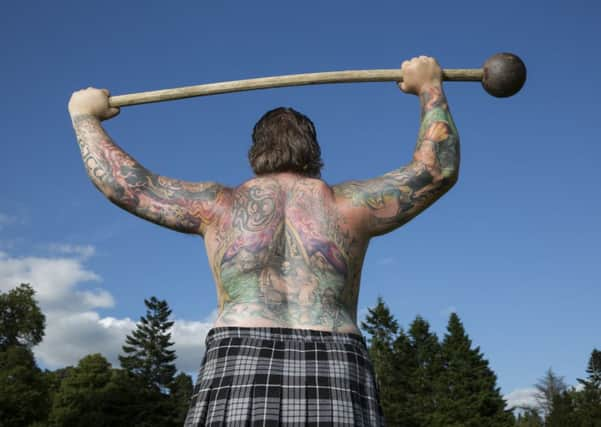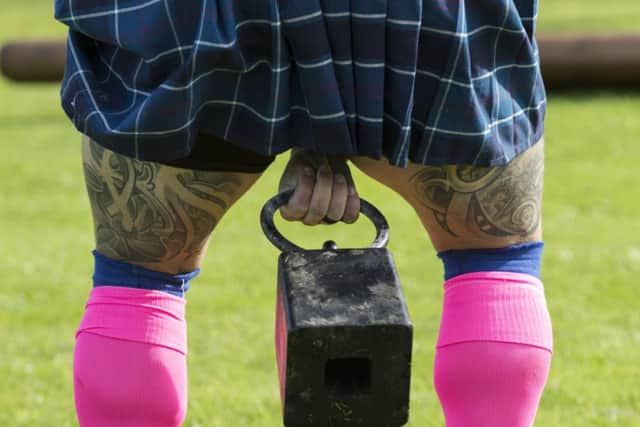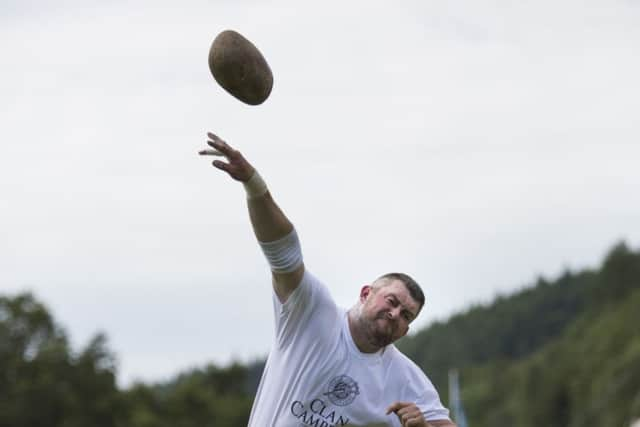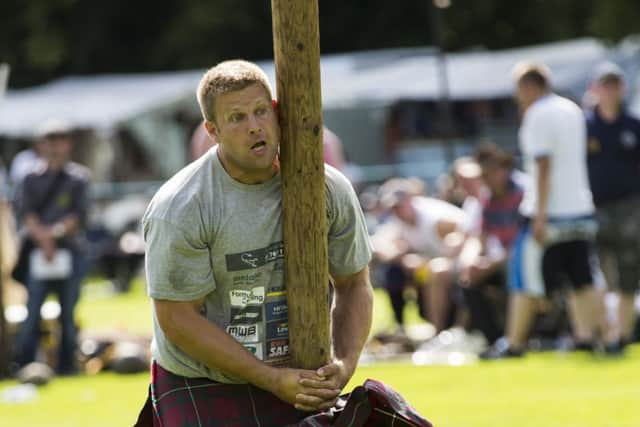Peter Ross: Hanging with heavies at Highland Games


THE stone is pitted and round, weighs 16 pounds and draws the mind to dragon eggs. It was lifted from the bed of the River Aray in the Victorian age and has served, ever since, as a test of strength at the Inveraray Highland Games. It is granite, formed around 425 million years ago, and right now is being held high in the air by Heidar Geirmundsson, a 30-year-old athlete known as Heisi who hails from the lava fields of western Iceland. Heisi is about to throw the stone – some 60 feet, he hopes – and as the crowd holds its breath, and as his right arm bends back and bulges, causing his Viking tattoos to warp and dance, one senses the collision of elemental and cultural forces in this moment: the hard rock from Scotland versus the rock-hard man from the far north.
He throws. He grunts: “Öch!” The stone arcs through the hot summer air and lands some distance short of the record. No matter. There will be soon be another rock, another test. For Heisi is one of a travelling band of overseas athletes who spend each summer competing at Scotland’s games and have come to dominate the sport. This is his fourth event in four days. That giant in the kilt over there tossing the caber? He’s more likely to be from St Petersburg than St Andrews; more likely Californian than Caledonian. He might even be – whisper it – English. This foreign lot, they’re coming over here, throwing our hammers and, jings, the worst thing is they’re pretty good at it.
Advertisement
Hide AdAdvertisement
Hide Ad“In Iceland, you grow up lifting stones,” Heisi had explained earlier in the gazebo where the athletes shelter from the sun, sipping energy shakes and, as the day wears on, cold beers. “You pit yourself against your friends to see who can lift the heavier stone. The heavier it is, the better I like it.” He shrugged hairy shoulders; pressed a plug of Icelandic tobacco up a nostril. “It’s just what we do. We throw big rocks. It’s in our genes, I guess.”


More than 60 Highland games take place in Scotland each year between May and September. Cash prizes are on offer for those winning the different heavy athletics disciplines. The money isn’t huge but it adds up. A high-performing “heavy” could walk away from a middle-range games with £500 cash in his sporran, and if he is able to travel to two or more each week during the summer, he can earn a decent whack. At Inveraray, home of the World Caber Championships, there is £400 for the winner of that event alone. There are expenses, of course, notably fuel for vehicles and those cavernous, ravenous bodies – “You eat more than you win,” says one Scottish competitor – but, especially for those athletes who come from eastern Europe and the Baltic states, the Scottish games represent an opportunity to boost their incomes considerably.
The Wenta brothers, Sebastian and Lukas, are regular winners on the scene – iron bros, made in Poland from girders. They come from the town of Tczew, and while Sebastian still lives there, working as a house builder, Lukas moved to East Kilbride 18 months ago and has found work as a mechanic. Lukas is the younger and smaller, aged 35, and relatively puny at a mere six foot six and 120 kilos. Sebastian, known as Wentyl, has four years and an inch on his brother, and weighs 155 kilos; his neck is almost two feet around, as are his biceps. But those are mere statistics. What they don’t give you is the look of the man: an extraordinary genetic splice of Eric Cantona and Popeye’s nemesis Bluto; the crucifix gleaming between his pecs is a golden statue in an alcove above the flying buttress of his belly. Wentyl is more gothic architecture than flesh, a soaring cathedral of meat and muscle. His nickname on the scene – “housewife’s choice” – comes larded in irony.
“Why Highland games?” he says in broken English. “For me, very good events. How many will I go to this year? I think 20. My best – 29 – two years ago. Scotland is good place.”
Sebastian, I ask, have you always been so big?


“Tak,” he replies. “Yes.”
There are 14 athletes taking part at Inveraray, only six of whom are Scottish. The international contingent comprises the Wentas, Heisi, an American, an Irishman, a Swiss, and a German with Schottland written across his T-shirt. England is represented by Scott Rider, a shot putter who has escaped for the day from the athletes’ village of the Commonwealth Games in order to attempt a defence of his caber world title. The Scots, inspired perhaps by the cosmopolitan air, are keen to show off their foreign language skills: “The weather today,” muses Stuart Anderson from Lochearnhead, “is f***in’ scorchio.”
Six homegrown athletes out of 14 is considered a decent ratio these days. You go to some games and there isn’t a single Scot. Heavies do not receive the funding given to Scots competing in mainstream athletics – discus, shot putt etc – and there is concern that without future support, the talent gap between us and the rest of the world will widen until, as the Highland games historian David Webster has written, “Scotland’s wonderful heavies may be in danger of becoming an extinct species”.
Despite this prospect of national embarrassment, there’s no noticeable tension at Inveraray, which is one of the few games to offer a separate tier of prize money for native competitors in order to make it worthwhile for Scots showing up; indeed, a fist-bumpingly fraternal air of friendly rivalry seems to characterise the heavy athletics scene. “We welcome anybody,” says Stephen King, Inveraray’s “local heavy”, a title with a happier resonance than it would have in, say, Govan. “We’ll throw against anybody. We’ll take them on and beat them.”
Advertisement
Hide AdAdvertisement
Hide Ad

Listen a little closer, though; talk to people off the record, and you do get to hear suspicion and resentment given sour voice. “You are aware that most of the foreign athletes are junkies?” says one Scottish competitor on the phone. “They’ve got arses like pin cushions. They don’t care about tradition. They don’t have any morals. They just want the prize money and they’ll win at any cost.”
The Scottish Highland Games Association has worked with UK Anti-Doping to carry out random tests for a range of banned substances including anabolic steroids and growth-hormones. There have been 50 or so tests carried out since 2009, and only one athlete, an American, has tested positive. He was banned for two years.
The World Highland Games Heavy Events Championships, which is not SHGA-affiliated, also operates a random testing policy. “I have not ever taken any steroids or any performance-enhancing drugs,” says Daniel McKim, the 32-year-old from Kansas City who is the current US and previous world champion. “I hate to see it come in and be a part of our sport, but it is.”
Is doping widespread in Highland games?
“Not like in strongman or power-lifting, but it is and it’s growing, I feel.”
McKim is a fascinating character. Six foot five and 300 pounds (above which weight, he snores horribly, much to his wife Natalie’s displeasure) he looks like an all-American Hulk – blond-haired, bright-eyed and totally, totally pumped – driven by rapture rather than rage.
The son of a preacher man, raised in Maryville, a small Missouri farming town, he is a devout Christian and father to five boys. He holds Bible study classes before Sunday games, inviting his “brothers in bulk” to pray, and identifies with Behemoth, the awesome and mysterious creature described in the Book of Job: “Behold now, his strength in his loins and his power in the muscles of his belly. He bends his tail like a cedar; the sinews of his thighs are knit together. His bones are tubes of bronze; his limbs are like bars of iron.”
McKim competes at the Highland games for the glory of God; the divine, he feels, is revealed through his strength. “When I turn the caber,” he says. “I want people to see and understand Him, not me.”
Advertisement
Hide AdAdvertisement
Hide AdThe world championships move around the globe. McKim won his 2013 world title in Dana Point, California. This year the venue is the slightly less sun-kissed Pittencrieff Park, Dunfermline. Unlike most Scottish games, the championships are invitation-only, and so today’s field of ten, including two Scots, represent some of the world’s strongest men. For those who have flown here from across the Atlantic, the grumbling of Iceland’s Bardarbunga volcano is a concern. If it erupts, their return flights may be cancelled, leading to the one thing these toughs truly fear – angry wives.
It is no accident that the world championships are taking place here, in a beautiful park overlooked by Dunfermline Abbey, the last resting place of Malcolm Canmore. As the historian David Webster, today tricked out in full Highland dress, explains in his running commentary, the 11th century king of Scotland held what can be regarded as a progenitor of the modern games in the year 1040. The real flowering of games took place during the 19th century, however, their popularity boosted greatly by the patronage of Queen Victoria.
Webster, an Aberdonian, is an important figure in the development of games overseas. He attended his first games in 1937. On his first visit to the Braemar Gathering, he had no interest in the presence of King George VI, being captivated instead by strongman royalty – the sculpted specimens of Scottish manhood busy with stones and caber. Webster has been organising games since the early 1950s and is the founder of these championships. He is a Zelig-like figure, internationally ubiquitous in his blue Balmoral bunnet. Just back from one games in Ontario, he is about to fly to another – in San Francisco.
For several years Webster was chief judge of the strongest man competition at Arnold Schwarzenegger’s sports festival in Ohio. Arnie and he are pals from way back. “I’ve known him since he was 19,” says Webster. “He was a body-builder and I was a judge at Mr Universe in London. He’s always pulling my leg about my age. He says I was a wine waiter at the last supper.”
Since the 19th century, when expats formed Scottish societies in America, Canada, Australia and New Zealand, our native heavies have crossed the oceans to compete. The best known was Donald Dinnie from Aboyne, a globetrotting Victorian superstar, all waxed moustache and constant kilt; for all his huge earnings, millions in today’s money, he refused to spend any of it on trousers.
The promotion of Highland games overseas accelerated during the 1960s, 70s and 80s as Webster took groups of heavies on tours of America, Canada, Scandinavia and Japan. Also important during the same period was Douglas Edmunds, a heavy athlete, well-connected, who has promoted the sport and culture worldwide. Edmunds is a giant of the games, literally and figuratively, twice world caber champion. The World Highland Games Heavy Events Championships are staged by Edmunds and his family, organised from their home in Carmunnock, a sort of ranch for heavies in which, at any given moment, one can stop by and find Russia’s strongest man singing Leadbelly songs in the front garden.
Edmunds is known on the scene as The Godfather and, as he is rather unwell at the moment, spends his time at Dunfermline seated at the side of the field, a Don Corleone-ish presence, black-clad and crag-faced, receiving tribute from the international athletes who approach for respectful handshakes and the chance of a few words.
Advertisement
Hide AdAdvertisement
Hide Ad“I’ve been involved in the Highland games since I was 17 and I’m now 70,” he says. “I’ve been involved in more Highland games, either as organiser or as an athlete, than anybody else in history. One of the things I’ve always tried to do is bring the games into prominence. It annoys the hell out of me that the Scottish Government and others don’t recognise their economic and cultural importance. Everybody and their granny’s wee society seems to get funding, but not the games. There’s this idea that they are always going to be there, but they are not. The games are in decline and without foreign athletes they’d be in big trouble.”
Edmunds believes that as well as creating an exotic, crowd-friendly spectacle, the international heavies raise the standard, forcing domestic athletes to train hard if they are to have a hope of winning. He is strongly opposed to the system of having two tiers of prizes – one exclusively for the Scots. “To me, that’s just looking after your own midden-heap. It’s a pathetic attempt to keep your wee pot of money to yourself, and not in the interests of the games at all.”
The foreigners certainly bring character. Look at Burger Lambrechts, the South African shot putter, a former Commonwealth Games gold medallist now enjoying an Indian summer as a heavy. Six foot six, built from bricks, in his spare time he likes to write poetry and hunt wildebeest. On arrival at Glasgow Airport, asked to state his business, he peered down at the customs officers from beneath the brim of his leather bush hat and declared: “I am here to learn to be a tosser.” The officials, unamused, spent a long time questioning him. Thus, a lesson was learned – in Scotland we like our burgers properly grilled.
Alan Hebert, a 57-year-old Californian with a bandana and Abe Lincoln beard, isn’t in it for the money or glory. “I’m not here to win,” he said in Inveraray. “I’m here to be here.” Visiting Scotland for the first time, he was keen to see the lands of his ancestors, and to fit competing around hiking with his wife. An IT guy at Stanford University, he has swapped Silicon Valley for testosterone glen and is having the time of his life. He’s what you might call “a lad o’ pairts” – an accomplished sailor and clarinetist, he plays in a klezmer band and makes his own kilts. He doesn’t care that he’s the oldest guy on the field – “If I stop, I’ll die. So I ain’t stopping.” He’s moved by the idea that the rocks and weights he is throwing in Scotland have been graced by the skin and sweat of the great heavies of the past.
“If you’re a thrower this is heaven,” he says. “A lot of these tough Scottish guys probably wouldn’t say this, but it’s spiritual. It’s simple and it’s spiritual and it’s good for your head.”
There is a certain grim irony in the fact that games in North America and elsewhere draw huge crowds – tens of thousands in some cases – while the Scottish originals are often precarious; run by volunteers, short of cash, only ever a couple of wet summers away from oblivion. Yet a Highland games on a sunny day can be a wondrous thing: the skirl and burl of pipes and dancers; the picnic rugs, the Scottie dugs; and most of all the true spirit of athleticism. It is too easily forgotten, amid all the tartan hoo-ha, that for the heavies these events are a serious business. “We’re here to compete. We’re not here to entertain the f***in’ tourists,” Stephen King said in Inveraray. He is 45, has been throwing for 30 years, and set two world records in the light and heavy hammers; yet, as he says, he has never once appeared on the sports pages of his local paper. He wants respect – for himself, for his peers, for the tradition of his sport. He finds the kitschy focus of the media maddening. “It is not my sporting ambition,” he says, “to get my picture printed on a tea towel.”
Given this lack of appreciation, it’s understandable that the present dominance of foreign athletes might stick in a few craws. Yet to outsiders, the personalities of some of these heavies are hard to resist.
Advertisement
Hide AdAdvertisement
Hide AdTake Matt Vincent. A 31-year-old from Baton Rouge, Louisiana, he is six feet tall, 270 pounds, and has thighs so large they make Chris Hoy’s look like Kate Moss’s. These serve to distract somewhat from his feet, which is a shame as he has DIRTY SOUTH tattooed across his toes; the nails painted robin’s egg blue and decorated with dainty golden anchors. Vincent has worked as a bouncer in a strip club, a tour manager for a rock band, and is now a sales rep in the oil industry. He describes himself as “equal parts asshole, clown, hipster and vagabond”. His voice is all bluegrass and mint juleps when he says: “I enjoy gettin’ pissed every now and then and causin’ a little trouble. You gotta live, too.”
He likes to travel, to smoke good cigars, to eat foie gras when he can find it. He wears sunglasses and a baseball cap while casually throwing a 56 pound weight over a bar 16 feet above his head. He listens to heavy metal on headphones to drown out the Dunfermline District Pipe Band. His socks are pink, his humour black. If he was a fictional character, he says, it’d be Patrick Bateman from American Psycho. He quotes Nietzsche and Henry Rollins. He trains long and hard, motivated by idealism and self-loathing, and it is hard to imagine anyone more distant from the clichéd porridge-packet image of a heavy; yet this is the guy who this year, right there in Dunfermline, wins the world championship. The best Highland games athlete in the world is a freakadelic Hercules with bourbon breath and a molasses drawl. And why not?
“Winning in Scotland feels f***in’ great,” he says afterwards, already packing his flight case. “Now it’s back to the States. Volcano permitting.”
Twitter: @PeterAlanRoss